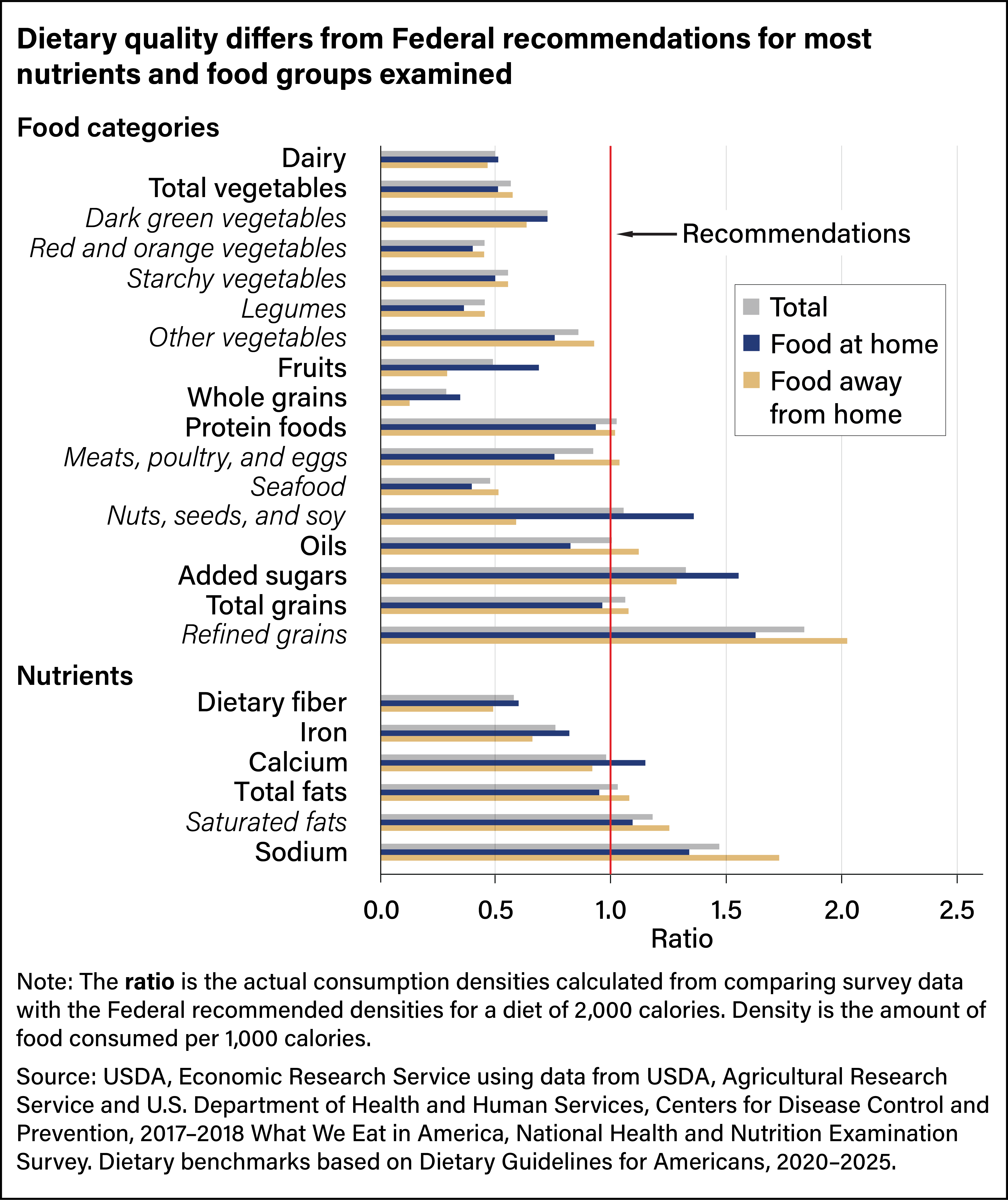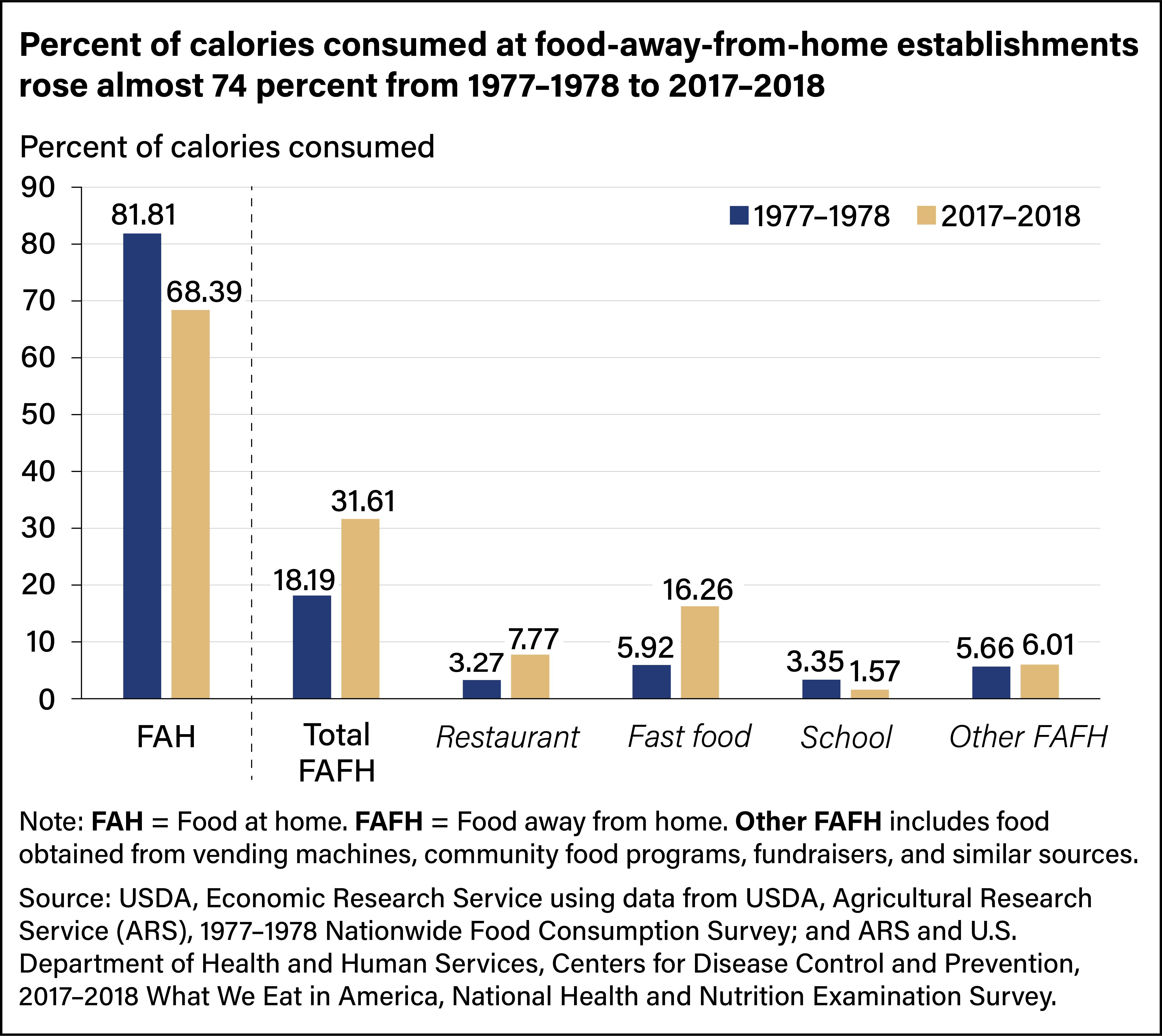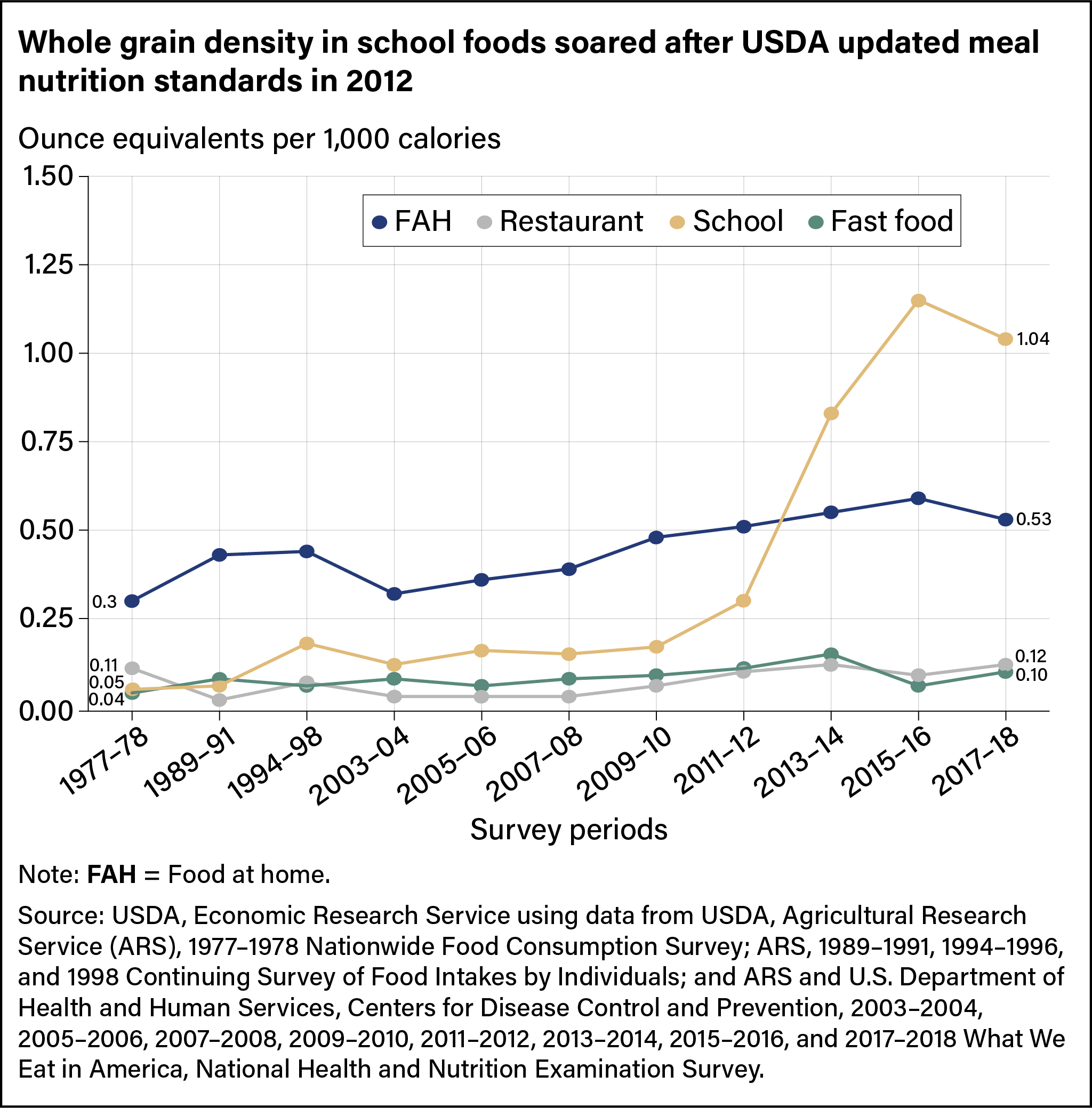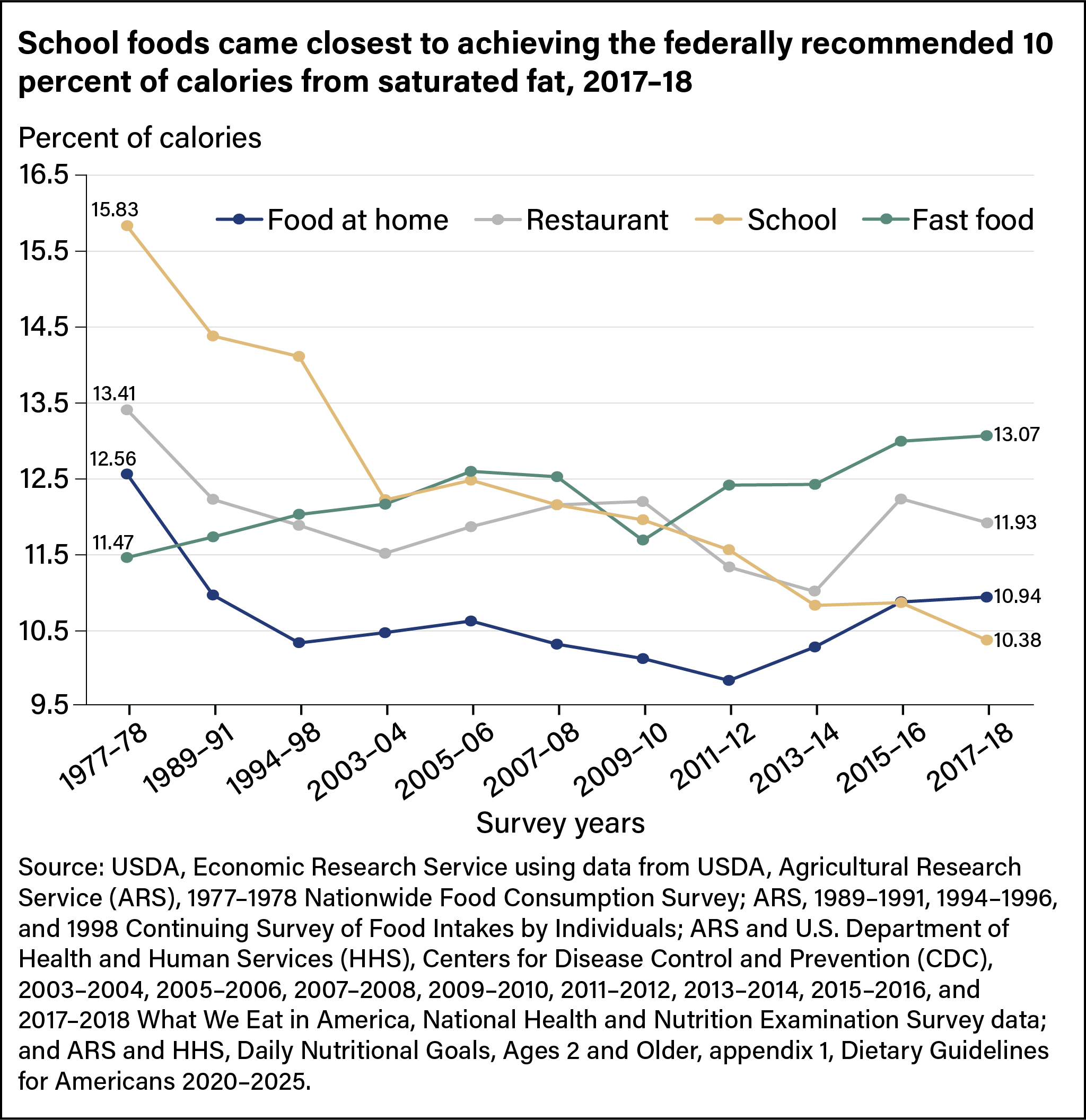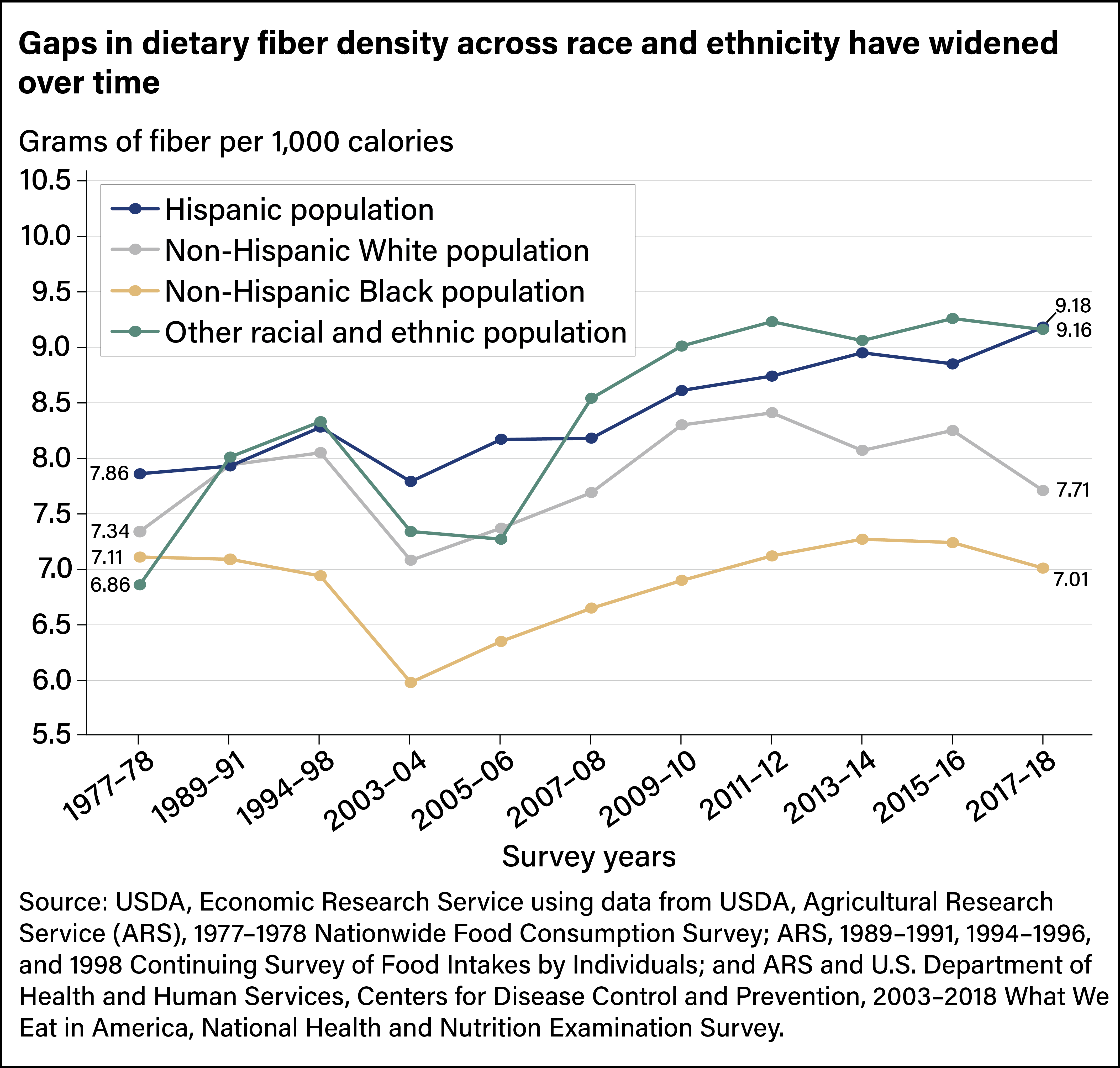
Food Consumption and Nutrient Intake Trends Emerge Over Past Four Decades
- by Joanne Guthrie, Biing-Hwan Lin and Travis A. Smith
- 8/28/2024
Highlights
- Federal food consumption survey data spanning 1977–2018 show how diet quality has changed over time. Comparing food and nutrient trends by sources where food was acquired and by selected demographic characteristics offers insights into differences in U.S. dietary quality.
- Between 1977 and 2018, food consumption shifted to more food obtained away from home at restaurants and fast-food places, where foods were of generally lower dietary quality than those from other sources.
- School foods came closer to achieving Federal dietary recommendations than other food obtained away from home, especially after 2011–2012, when updated nutrition standards for USDA school meals were implemented.
For decades, USDA has conducted food consumption surveys, currently in partnership with the U.S. Department of Health and Human Services. Using USDA nutrient and food composition databases, information from these surveys is converted into measures of food group and nutrient intakes, allowing researchers, policymakers, public health professionals, and nutrition educators to assess how U.S. diets compare with nutrition recommendations. Researchers from USDA, Economic Research Service (ERS) and the University of Georgia used survey data from 1977 to 2018 to assess the quality of current diets compared with Federal dietary recommendations and to examine consumption trends over the four decades.
U.S. Diets Do Not Meet Most Federal Recommendations for Food Groups and Nutrients
Since 1980, the Federal Government has published Dietary Guidelines for Americans (DGA), based on expert recommendations on what and how much to eat. By law, the DGA recommendations are updated every 5 years, and a Federal advisory committee of nutrition experts currently is working on the 2025–30 update. These experts rely on data from many sources, including Federal food consumption surveys, to understand how U.S. consumers eat and how diets compare to recommendations.
In 2017–18, average food consumption and nutrient intakes of U.S. consumers indicated considerable room for improvement in meeting DGA recommendations. Dietary quality is measured by nutrient and food-group density, or the amount of intake for every 1,000 calories. On a density basis, U.S. consumers are eating less-than-recommended amounts of many nutrients and food groups and higher-than-recommended levels of others. On average, U.S. diets differed by more than 20 percent from the recommended density level for 16 of the 23 nutrients and food groups examined. Among nutrients, diets included lower-than-recommended densities of dietary fiber and iron and higher-than-recommended densities of saturated fats and sodium. For food groups, lower-than-recommended densities were found for dairy, total vegetables, dark green vegetables, red and orange vegetables, starchy vegetables, legumes, other vegetables, fruits, whole grains, and seafood. Densities of added sugars and refined grains were higher than recommended. Food groups and nutrients with densities within 20 percent of the recommended range included calcium, total fats, protein foods overall, the meats, poultry, and eggs category, total grains, oils, and the nuts, seeds, and soy category.
U.S. Consumers Eating More Food Away from Home —With Implications for Diet Quality
Data indicate that where food was obtained plays a major role in dietary quality. Food obtained at supermarkets, grocery stores, and similar retail outlets mainly for home preparation and consumption (food at home, or FAH) was generally of higher dietary quality than food obtained from restaurants, fast-food, and other establishments for consumption away from home or through takeout or delivery (food away from home, or FAFH). This is a particular concern because data indicate FAFH is a growing part of the diets of U.S. consumers.
Researchers examined data on food obtained from grocery stores and similar retailers (FAH); at restaurants; at fast-food establishments; at elementary, middle, and high schools or child daycare settings; and at other sources away from home. One of the most notable changes in U.S. eating habits over the four decades studied was a decrease in consumption of FAH in favor of FAFH.
Food purchased for consumption away from home generally is considered of lower dietary quality than FAH. A notable exception is the food children eat at school or daycare. School-obtained food consists primarily of USDA school meals (lunches brought from home are considered as FAH), which must follow Federal nutrition standards. For example, school meals have long been required to include milk, and throughout the research period, school food has been the richest source of calcium in children's diets. Nutrition standards for USDA meals were updated in 2012 to emphasize low-fat or nonfat milk, to require more fruit, whole grains, and a healthier mix of vegetables, and to limit saturated fat and sodium. Following these changes, school food became the richest source of fruit and whole grains in children’s diets.
At the same time, the density of saturated fat and sodium in school foods declined. In 2017–18, school food was the only food source that came close to meeting the standard of 10 percent of calories or less from saturated fat.
For sodium, all food sources exceeded the benchmark density of 1,150 milligrams (mg) per 1,000 calories, but school foods came the closest at 1,343 mg per 1,000 calories.
Dietary Quality Disparities Emerge Among Demographic Groups
The ERS and University of Georgia researchers also identified differences in dietary trends associated with demographics. This information may be helpful to policy and program officials as well as nutrition educators working to reduce disparities in dietary quality across demographic groups in the United States.
They found that dietary fiber density did not vary across race and ethnicity in the early years of the study period, but the gap in fiber density across race and ethnicity has since widened. Since 1994–98, the diets of non-Hispanic Black people have been lower in fiber density than those of non-Black people. In 2017–18, Hispanic populations and individuals of other races and ethnicities had a diet of 9.2 grams of fiber per 1,000 calories, higher than the 7.7 grams consumed by non-Hispanic White people and the 7 grams consumed by Black people.
In 2017–18, diets of more highly educated individuals had lower added sugars densities than those of less-educated individuals: 7.2 teaspoons per 1,000 calories among those who attended college, compared with 8.5 teaspoons per 1,000 calories among individuals with less than high school, and 8.4 teaspoons per 1,000 calories among those with a high school education. Densities of added sugars intakes also differed by income level. In 2017–18, foods consumed by high-income households contained 7.2 teaspoons for each 1,000 calories, compared with 8.6 and 8.4 teaspoons for medium-income and lower income households.
This article is drawn from:
- Lin, B., Guthrie, J. & Smith, T. (2023). Dietary Quality by Food Source and Demographics in the United States, 1977–2018. U.S. Department of Agriculture, Economic Research Service. EIB-249.
You may also like:
- Food Consumption, Nutrient Intakes, and Diet Quality. (n.d.). U.S. Department of Agriculture, Economic Research Service.
- Food Availability (Per Capita) Data System. (n.d.). U.S. Department of Agriculture, Economic Research Service.
- Guthrie, J. & Lin, B. (2021, September 7). Food Consumption and Nutrient Intakes Data Product Shines a Light on U.S. Diets. Amber Waves, U.S. Department of Agriculture, Economic Research Service.
- Saksena, M., Okrent, A., Anekwe, T.D., Cho, C., Dicken, C., Effland, A., Elitzak, H., Guthrie, J., Hamrick, K., Jo, Y., Lin, B., Mancino, L., McLaughlin, P.W., Rahkovsky, I., Ralston, K., Smith, T.A., Stewart, H., Todd, J.E., Tuttle, C. & Hyman, J. (2018). America’s Eating Habits: Food Away From Home. U.S. Department of Agriculture, Economic Research Service. EIB-196.


